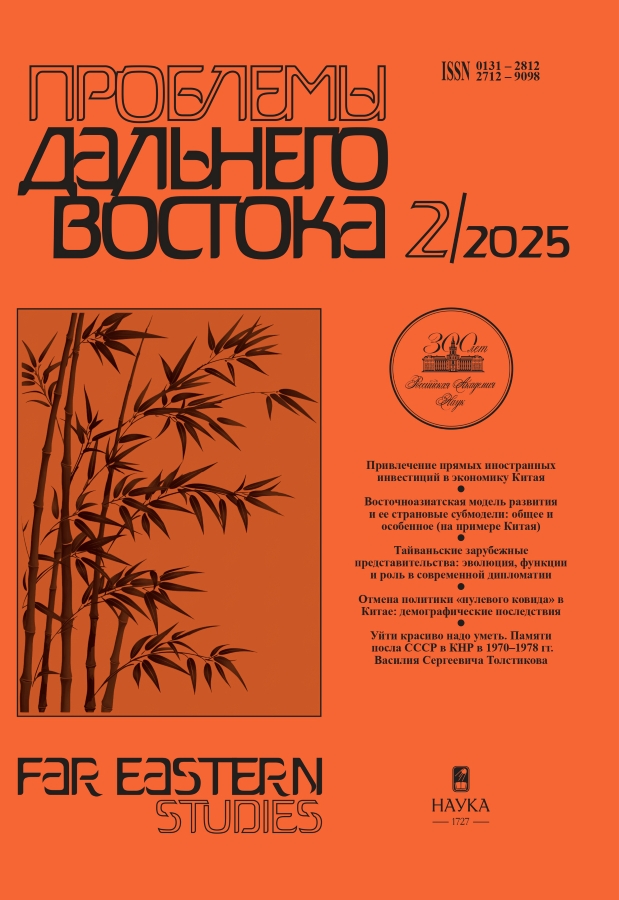Problemy Dalnego Vostoka
“Problemy Dalnego Vostoka” (eng. “Far Eastern Studies”) is an academic and socio-political journal founded in March 1972.
The frequency of the Journal is 6 issues per year.
Founders
- Russian Academy of Sciences
- Institute of China and Contemporary Asia of the Russian Academy of Sciences
Publisher
- Russian Academy of Sciences
The journal is published under the supervision of the RAS Department of Historical and Philological Sciences (OIFN RAS).
About the journal
The journal gives information on the history, culture, politics and economy of the Asia-Pacific countries, offering the readers an opportunity to monitor the development of international cooperation, bilateral and multilateral relations in this dynamic and strategically important region of the world, which includes – in addition to the leaders of the modern world economy China and Japan, rapidly growing India, Vietnam and other ASEAN countries – Siberia and the Russian Far East with their colossal potential.
Among the authors of the journal are well-known political and public figures, prominent academicians, government officials, experts and researchers from Russia and foreign countries.
According to experts who constantly read the journal, it manages to combine political relevance, constant search for new ideas and new methodology and careful adherence to the best traditions of the Russian oriental studies, avoid being ideologized and preserve academicism. A wide range of issues under consideration, the publication of materials that are diverse in thematic and conceptual terms allow the publication to interest a wide variety of readers, each of whom finds something informative in it.
Since 2002, some articles of the journal have been translated into English and published as a separate periodical (“Far Eastern Affairs”, ISSN 0206-149X).
Media registration certificate: № 0110158 от 04.02.1993
Current Issue
No 2 (2025)
Politics
Taiwan’s Representative Offices: Evolution, Functions, and Their Role in Contemporary Diplomacy
Abstract
 9-26
9-26


Technological Rivalry between China and the United States: the Clash of Xi Jinping's Digital Initiatives and Trumponomics 2.0
Abstract
 27-42
27-42


Economics
Attracting Foreign Direct Investment into China's Economy
Abstract
 43-55
43-55


The State and Prospects of Corn Production Development in China: Analysis of Grain Balance
Abstract
 56-70
56-70


Territorial Organization of the Logistics Industry in the Countries of Southeast Asia
Abstract
 71-85
71-85


The Republic of Korea on the International Nuclear Technology Market
Abstract
 86-97
86-97


State and society
China's Ending of “Zero Covid” Policy: Demographic Consequences
Abstract
 98-115
98-115


View point
The East Asian Development Model and Its Country Submodels: General and Specific (Based on the Example of China)
Abstract
 116-130
116-130


Russian sinology
Knowing How to Leave Gracefully. In Memory of the USSR Ambassador to the PRC (1970–1978) Vasily Sergeyevich Tolstikov
Abstract
 131-139
131-139


Military build-up
The Views of Chinese Military Analysts on the Strategic Aspects of Deterrence
Abstract
 140-153
140-153


Military-Political Relations between the Republic of Korea and the United States at the Present Stage
Abstract
 154-166
154-166


History
Modern Chinese Historiography of Russian-Chinese Medical Relations in the Early 20th Century
Abstract
 167-181
167-181


Scientific events
Annual All-Russian Conference “Modern Chinese State” 2025
 182-192
182-192


XXIX Conference of Korean Studies in Russia and CIS Countries
 193-199
193-199


Book reviews
Book Review: Malyavin V.V. Chinese World: Roots and Crown. Moscow: RIPOL classic, 2024. 775 p.
 200-202
200-202











